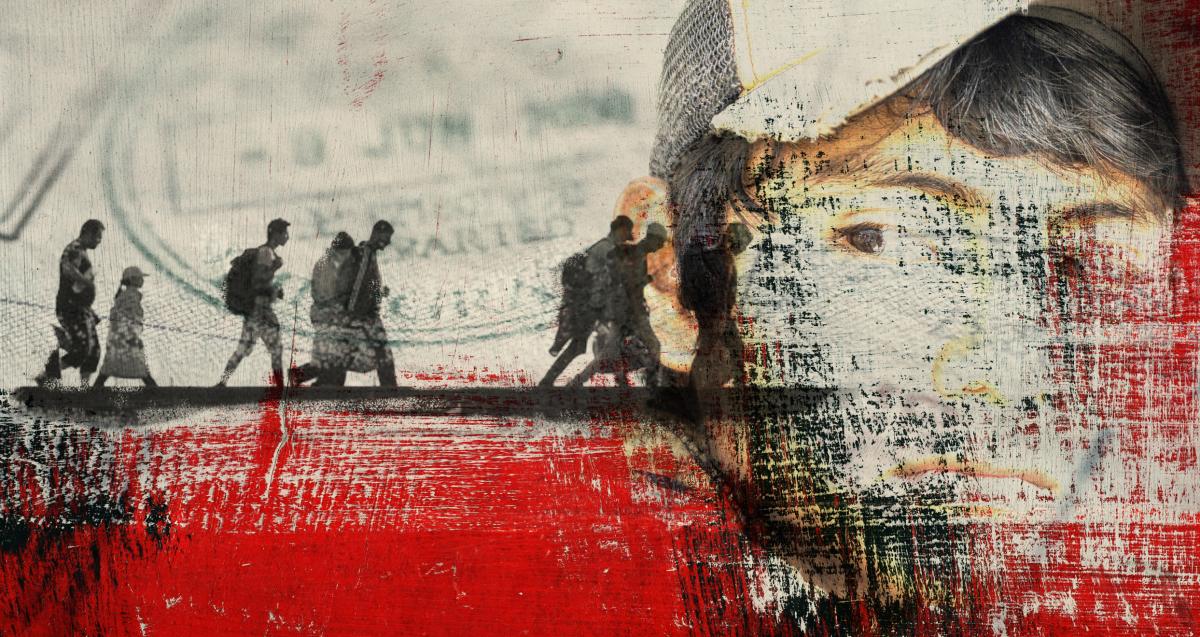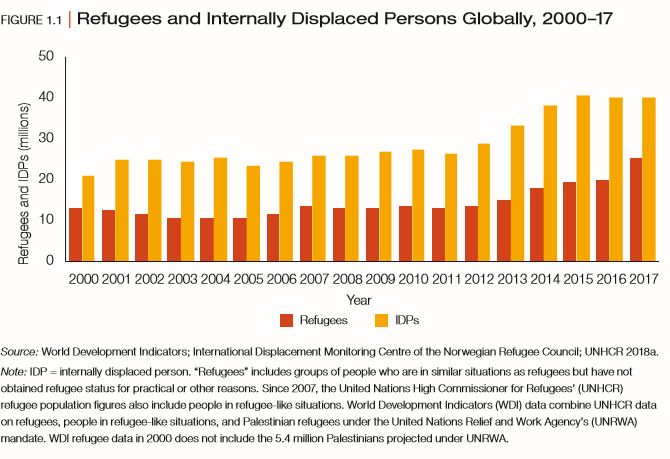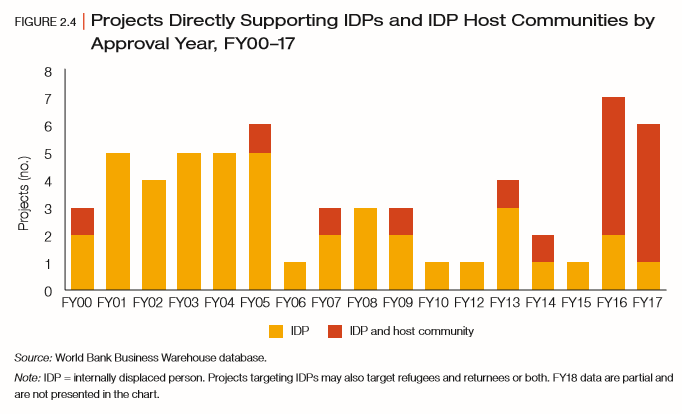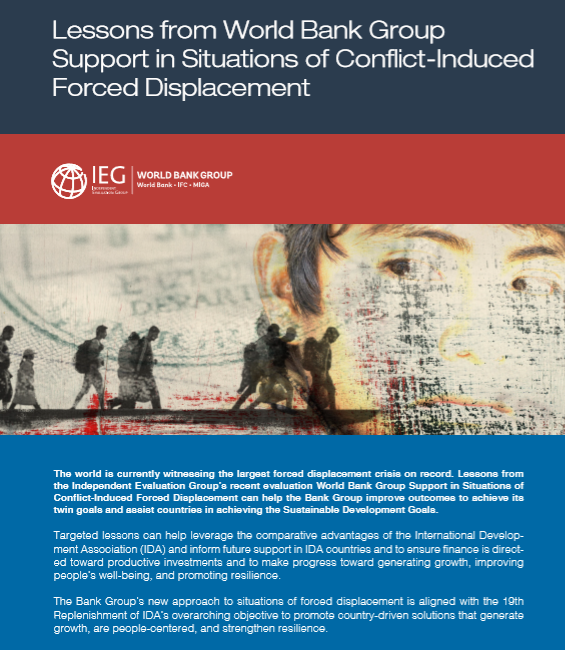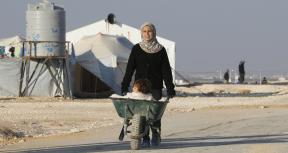The World Bank Group’s Development Approach to Situations of Forced Displacement
The World Bank Group identified four core dimensions for its recent development approach:
Socioeconomic aspects of the displaced: Tailored approaches and special interventions to address the specific vulnerabilities associated with forced displacement to reduce poverty among the forcibly displaced.
Host communities: Interventions to address the negative impacts forced displacement imposes on host countries and host communities. An influx of forcibly displaced people poses a risk to progress made toward poverty reduction and shared prosperity. The Bank Group’s potential role includes building social cohesion and supporting economic opportunities to leverage opportunities presented.
Medium- to long-term perspective: Institutions and policies to promote economic opportunities.
Partnerships: Broad partnerships with government, other partners, the private sector, and civil society, especially in areas where the World Bank Group does not have a comparative advantage.
Source: World Bank Group 2016.
More about the World Bank’s Development Approach to Forced Displacement
View the Theory of Change underpinning the Bank Group’s development approach to engaging in situations of forced displacement
Findings: Evolution in Bank Group Country Strategies, Advisory Services and Analytics, and Financing
- The World Bank Group’s country strategies reveal limited engagement in countries with large forcibly displaced populations but show an evolution consistent with growing awareness and understanding of the effects of forced displacement.
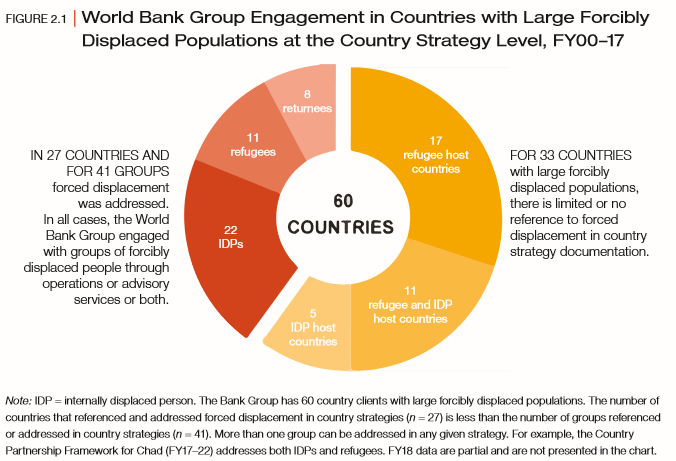
- Since fiscal year 2016, the Bank Group’s analytical, financial, and operational support has become more aligned with its stated development approach building on lessons from past engagements. This is an important shift.
- Advisory services and analytics have shifted from providing a rationale for Bank Group engagement in situations involving conflict induced forced displacement to context specific needs assessments focused on evidence-based, medium-term solutions.
- The World Bank successfully mobilized new financing to support situations involving conflict-induced forced displacement and crowded-in funding from other donors. World Bank support for populations forcibly displaced by conflict and their host communities has increased, become more balanced, and focused on priority sectors to generate economic opportunities. These are significant achievements.
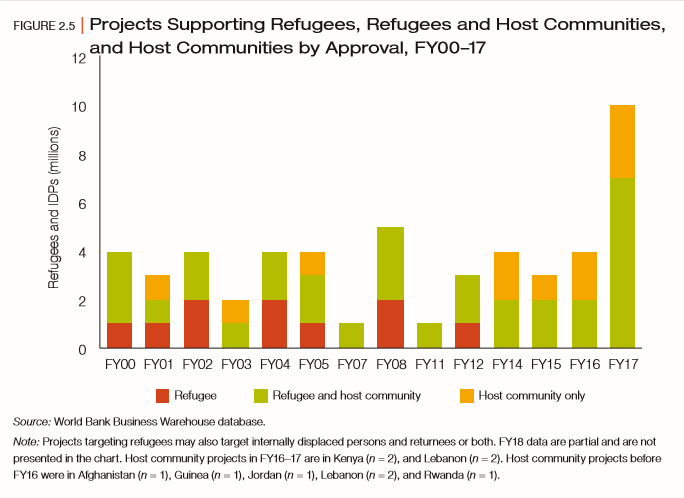
- At the same time, the Bank Group has not yet fully leveraged its comparative advantages in implementing its development approach. Evidence generated from analytical and advisory services needs to be translated better into context-specific policy dialogue, project design, and programming. Project design, in particular, could further address the specific needs and vulnerabilities of conflict-induced forcibly displaced persons and their host communities, especially the specific needs and vulnerabilities of the women and children among them. Projects should also more systematically include specific indicators to monitor and evaluate the effects on affected populations.
Findings: The Bank Group’s Policy Dialogue and Strategic Partnerships
- The World Bank engages and coordinates with humanitarian actors and development organizations at various levels, but coordination could be further strengthened.
- Additionally, select partnerships at the country level could be leveraged to ensure sector coherence and to foster policy dialogue to enact institutional reforms toward self-reliance that address the vulnerabilities of forcibly displaced persons.
- The Bank Group could also increase engagement to catalyze the private sector’s role in situations of conflict-induced forced displacement.
More findings related to Policy Dialogue and Strategic Partnerships (Chapter 3)
Findings: Removing Impediments to the World Bank Group’s Development Approach
- Internal and external factors inhibit the World Bank Group’s development response to support refugees, internally displaced persons, and host communities.
- External factors reviewed here include the unpredictability, complexity, and unique nature of each displacement situation; reduced local government capacity; macroeconomic and development challenges; and complex political economy factors.
- Internal factors include varying levels of active leadership in Country Management Units; the World Bank’s country engagement model, which, together with weak regional platforms, can constrain regional work; and limited Bank Group experience, time, and incentives needed to realize the development approach.
Recommendations
The evaluation makes five recommendations for the Bank Group to fully leverage its comparative advantages to operationalize its intended development approach:
Recommendation 1. Intensify the use of analytical work related to conflict-induced forced displacement to inform policy dialogue, programming, and operational design. This could involve better aligning policy dialogue, programming, and the design of operations, with the context-specific understanding and medium-term solutions emerging from analytical work that focuses on institutional changes and the needs of the displaced—including women and children—and host communities.
Recommendation 2. Improve monitoring and evaluation to demonstrate the intended development impacts on displaced populations and host communities—especially women and children. This may entail clearly defining monitorable outcome indicators; disaggregating these indicators, including by gender and age (as relevant) to monitor outcomes for forcibly displaced populations and host communities; and building capacity at the country level to target relevant populations and monitor results.
Recommendation 3. Foster selective partnerships with key humanitarian and development agencies at the country level and promote stronger coordination with key agencies and the government to leverage the World Bank’s comparative advantages to operationalize the development approach in situations of forced displacement. This may guide the World Bank’s efforts to selectively use, sequence, or customize its instruments while supporting further sector coherence and policy dialogue with client governments. This may entail more systematically mapping the activities of humanitarian and other development agencies to identify respective areas and sectors of comparative advantage; customizing types of partnerships and coordination mechanisms to local contexts and partners’ mandates; and, among other factors, setting up clear expectations of country-level and sector-specific objectives and streamlined coordination arrangements to make coordination mechanisms and partnerships work better.
Recommendation 4. Identify and catalyze private sector solutions to promote the self-reliance and resilience of the displaced and host communities. This may entail the Bank Group conducting analytical work to address knowledge and information gaps in how to engage effectively with private actors in the formal and informal sectors and in a diverse set of situations of forced displacement. This may also entail the World Bank, IFC, and the Multilateral Investment Guarantee Agency identifying market opportunities and business models, adapting instruments, addressing weaknesses in the policy and regulatory frameworks, providing information to create business opportunities, and working with existing and new partners (such as philanthropic organizations, nongovernmental organizations, and social enterprises) who support private sector development. World Bank Group Support in Situations Involving Conflict-Induced Displacement
Recommendation 5. Ensure Country Management Units can effectively operationalize the World Bank Group’s development approach in situations of forced displacement. This may entail making sure Country Management Units have the required expertise and incentives to engage governments in sensitive dialogue; push for contextualized, medium-term programming for refugees and host communities; and invest in time-intensive coordination processes, both across the Bank Group and with other partners.
View a summary of IEG's findings from the evaluation
IDA Lessons Note: Support in Situations of Conflict-Induced Forced Displacement
The final IDA19 replenishment meeting took place in Stockholm, Sweden on December 12 and 13, 2019. The global community renewed its commitment to the world’s poorest countries with $82 billion for IDA. The IDA replenishment cycle provides an opportunity to deepen the discussion on issues facing IDA countries and seeks partners’ guidance on policy and financing approaches to address them.
IEG’s evaluation provides a series of evidence-based lessons to inform the IDA’s future role in this area.


